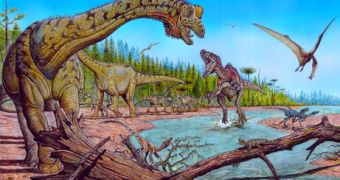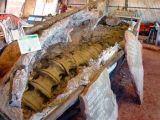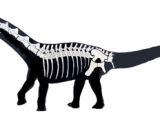Dinosaurs may have been big, but these ones dwarf them all: a newly discovered herbivorous dinosaur from Patagonia (Southern Argentina) was 105-foot (32-meter) long! Based on the neck structure, the new dino seems to represent a novel type of Titanosaur.
It was dubbed Futalognkosaurus dukei, meaning "giant chief" in Mapuche (Araucan) Indian language and for Duke Energy Argentina, which funded the skeleton's digging.
"This is one of the biggest in the world and one of the most complete of these giants that exist," said lead author Jorge Calvo, director of the paleontology center at the National University of Comahue, Argentina.
The giant roamed the Earth 88 million years ago, during the late Cretaceous period. First bones were discovered on the banks of Lake Barreales in the Neuquen province in 2000 and since then the dinosaur's neck, back region, hips and the first vertebra of its tail have been recovered.
"I'm pretty certain it's a new species. I've seen some of the remains of Futalognkosaurus and it is truly gigantic." agreed Peter Mackovicky, associate curator for dinosaurs at Chicago's Field Museum, not involved in this research. "The neck alone must have been 56 feet (17 meters) long, and by studying the vertebrae, the tail probably measured 49 feet (15 meters)." said Calvo.
The dinosaur was over 43 ft (13 m) tall and the spinal column was around 9 tons heavy when excavated, while just one neck vertebra alone was over 3 ft (1 m) high.
"I am impressed by the sheer amount of skeleton recovered. I should really try to underscore how incredible it is to have partial skeleton of something this size. With these kind of bones you can't study them by moving them around on the table; you have to move around them yourself. It shows us the upper limit for dinosaur size. There are some that are bigger but they all top out around this size." said Jeff Wilson, an assistant professor of paleontology at the University of Michigan, who reviewed the finding.
Two other extremely big dinosaurs were also found in Patagonia: Argentinosaurus, around 115 ft (35 m) long and Puertasaurus reuili, 115 - 131 ft (35-40 m) long.
Still, scientists have discovered just a few vertebrae of Puertasaurus and the skeleton of Futalognkosaurus still lacks all the bones from its limbs.
"North America's dinosaurs don't even compare in size. Dinosaurs do get big here, but nothing near the proportions we see in South America." said Mackovicky.
In fact, in Late Cretaceous, sauropods were long extinct in the more advanced dinosaur fauna of North America and Asia, being replaced by duck-billed and horned dinosaurs, which even if big, did not reach such sizes, being compared rather with elephants and mammoths.
The location where Futalognkosaurus was found is an El Dorado for paleontologists, with over 1,000 specimens, comprising 240 fossil plants, 300 teeth and several dinosaur species.
"As far as I know, there is no other place in the world where there is such a large and diverse quantity of fossils in such small area. That is truly unique," said co-author Alexander Kellner, from the Brazilian National Museum.

 14 DAY TRIAL //
14 DAY TRIAL // 

